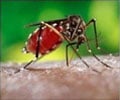Malaria, a climate sensitive disease, which at low air temperatures inhibits the development of the malaria parasites causing the disease.

‘The development of the Plasmodium falciparum and P. vivax parasites can be stopped at air temperatures below 18°C and 15°C.’





Malaria is a climate sensitive disease, and while the biology of malaria transmission is complex, sufficiently low air temperatures inhibit the development of the malaria parasites that cause the disease.Low temperatures also impede the development rates and population density of the Anopheles mosquito, which transmits the disease.
Dr. Bradfield Lyon, a research professor at the University of Maine and lead author on the study, indicates "Air temperatures below approximately 18°C and 15°C, respectively, effectively stop the development of the Plasmodium falciparum and P. vivax parasites responsible for the majority of malaria cases in Ethiopia."
"While locations of sufficiently high elevation have temperatures below these thresholds, our research examined how these "threshold elevations" have been changing with time across the highlands."
The study, published in the journal Environmental Research Letters, utilized a newly developed national temperature dataset for Ethiopia, which combines hundreds of surface station observations with climate model output that incorporates satellite data and other information.
Advertisement
The study identified statistically significant increases in elevation for both the 18°C and 15°C thresholds in highland areas between 1981 and 2014.
Advertisement
The researchers point out that exceeding the minimum temperature thresholds necessary for malaria transmission does not in itself point to an increase in the prevalence of malaria.
"While the dynamics of malaria transmission are complicated and control efforts may significantly limit the impact of these temperature changes, our study shows a clear softening of the climate barrier to transmission in the Ethiopian highlands, potentially putting more people at risk," said study co-author Dr. Madeleine Thomson, a senior research scientist at the International Research Institute for Climate and Society.
"Until quite recently, undertaking this type of study was not possible owing to a lack of quality controlled and sufficiently high spatial resolution climate data," said Lyon. "These new data allow us to examine the climate of the highlands in much more detail and confirm some of the anticipated changes of a warming Earth."
Source-Eurekalert












